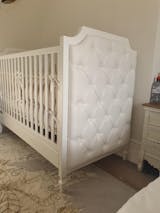experts guide curtains and window treatments
As a new patent or parent-to-be, your child safety and well-being is your top priority. Choosing the appropriate window treatment for your baby's nursery is probably one of your biggest decisions, this will have an influence on the time you take to put your baby to sleep during the day.

When it comes to window treatments for the nursery you have so many options to choose from which is great–but it can also be overwhelming. So, what matters the most? What are the best window shades for your child’s room?
Should Your Nursery Have Blackout curtains or blinds?
Experts say newborns (0-3 months) require 14-17 hours of sleep, infants (4-11 months) require 12-15 hours of sleep, and toddlers (1-2 years) require 11-14 hours of sleep. So, when designing a nursery, you really need to consider whether your baby is going to be able to nap during the day.
If the nursery gets a lot of natural light, it can be difficult for the baby to sleep during peak sunlight. This is where the blackout lining can help. When you have your curtains or roman blinds made, ensure you ask the makers to line them with blackout material. This will filter out 99% of light, and create a darker (and more energy efficient) environment.
Keep drapes away from the baby’s bed
Even a month old baby can grab the drapes and pull fairly hard. And that can be very dangerous. Even a lightweight curtain could be dangerous for a small baby who might not be able to throw it off. To be safe, try to keep curtains away from the baby’s bed.
The very best way to do that? Keep the bed away from the windows. That’s actually also better for making sure the bed is in the area that’s least affected by a drop – or rise – of the temperature outside.
Install the curtains in a secure way
In the nursery, anything that has the potential to fall and hurt a baby needs to be very securely held in place. That goes for furniture and also for your window covers. The heavier they are, the more attention you need to pay to make sure they firmly adhere to the wall. If you’re not sure how to do that, consult with a professional.
Measuring for Blinds:
Inside-Mounted Horizontal Blinds
- Measure exact window width at top, middle, and bottom.
- Use the narrowest width. Do not make any deductions - provide the exact measurements of the narrowest width.
- Measure exact window height at the left, middle, and right side.
- Use the longest height. Do not make any deductions - provide the exact measurements of the longest height.
Outside-Mounted Horizontal Blinds
- Measure the exact width where the blind is to be placed.
- Add at least 3 inches for overlap (1-1/2" per side) for optimum light control and privacy.
- Measure exact height from the top of the proposed head-rail location to the base of the sill. If there is no sill, measure to where the blind is to reach.
- Add 1-1/2" to the height for optimum light control.
Measuring for Curtains:
First, you should choose your curtain pole or track, we recommend measuring the width of your window recess and allow for any overlap, we recommend adding 40cm.
Once you have the width of the track your curtain makers should know the width of the curtains and the number of hooks/eyelets they should add.
The second thing you need to decide is the drop. There are 3 common drops:
- Above the sill
- Bellow the sill
- Floor Length
Curtain Heading Types:
There are so many Curtain Heading Types to choose from, at The Baby Cot Shop we have 3 that are popular:
- Double Pinch Pleat
- Triple Pinch Pleat
- Eyelet
We hope this was helpful. Read all our Expert's Guides here.
Questions? Our expert advisers are always ready to help. Call us on +44 203 371 7530 or visit us at our London Showroom.


